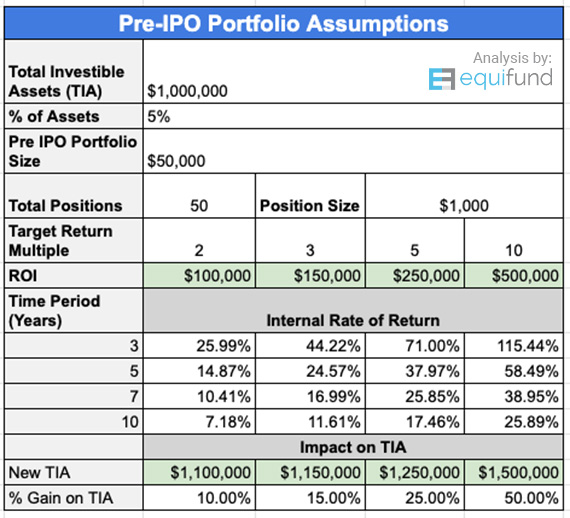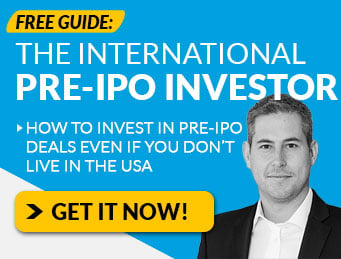As investors, there’s one question we should know the answer to before committing any funds…
No, it’s not the valuation or the deal terms (although those are important)…
The #1 thing we must understand is how we – the investor – expect to make money in the deal.
And I use the word “expect” because having proper “expectations” is key; Especially when you’re investing in more speculative plays (like Pre-IPOs).
With this goal in mind, let’s take a quick step back and talk about…
The difference between private markets and public markets
If you’re reading this, chances are you’ve heard of the stock market.
In the public stock markets, investors can buy and sell shares during normal market hours.
All prices are quoted in near real time, you have additional financial information about the company, and you can know instantly what the shares are approximately “worth,” based on the most recent trade.
However, the private stock markets are different for one very important reason; There is rarely an established public market to sell your shares!
This means there is no stock ticker, no live stock quotes, and no real “updates” in terms of how the stock is doing on a day-by-day basis.
While the shares may appreciate “on paper” as the company raises capital at higher valuations – or is otherwise valued at higher dollar amounts – the investor can’t cash-in on that appreciation until they can sell their shares to another buyer.
In the private markets, any trading is usually restricted to a small secondary market – which may or may not exist – with little to no trading volume or interest.
But if you’re going to invest the way the wealthy do – in the private markets – it means you have to take the good with the bad.
Depending on a lot of factors, your money could be locked up for 1, 3, 5, 7, even 10 years or more.
Because of this illiquidity, investors expect a higher rate of return over the long haul… which venture capital and private equity have continued to statistically deliver.
However, we recognize that most individuals aren’t interested in having their money locked up for 5-10 years the way many institutional investors can.
Generally speaking, we are looking for companies that may have a liquidity event within 12-36 months.
- Please keep in mind, these investments should still be considered long-term investments as that should increase the probablity of a positive outcome.
This way, investors might choose to exit positions early if they need capital, or they can choose to hold that position long term in search of bigger gains.
How do I make money in private market investment opportunities?
There are three ways you “make money” in private market deals:
- The company issues a distribution or a dividend.
- The investment pays some sort of interest payment (usually a “bond” or “convertible note”).
- You – the investor – sell your shares to someone else at a higher price than what you bought them for (i.e when the company goes public or is acquired).
Statistically speaking, more than 90% of privately held companies will sell their company to another company as an exit (via a “Merger” or “Acquisition”).
In the late 1990s through 2000, both IPOs and a sale of the business were popular. But since 2000, IPOs have declined substantially, and a sale, either to a strategic buyer or a buyout fund, has become the preferred vehicle for exit
If this is the case, you will likely sell your shares to the acquirer via a “Share Purchase Agreement.”
Alternatively, you might be offered a “stock swap” in which you would trade your shares for shares in the acquiring company.
- Note: there’s a whole category of provisions known as “Drag Along” and “Tag Along” that spell out what happens in the event of the sale of the company. We’ll cover this another time.
However, if they plan on going public – or if they are already public – you will have to deposit your shares into a brokerage account before you can trade your shares in the public markets.
What kind of returns should I expect (and how fast)?
Please keep this in mind: The greatest investor of all time – Warren Buffett – has overseen the creation of $600 billion in shareholder value and delivered an average compounded annual growth rate (CAGR) of 20.1%.
Since 1965, the per-share market value of Berkshire Hathaway is up 3,641,613%, compared to the 30,209% of the S&P 500 (a 10.5% CAGR).
Even crazier, substantially all of Buffett’s net worth is invested in Berkshire Hathway (which in turn owns a diversified portfolio of investments).
While he might not be investing in speculative early stage companies, it helps illustrate an often overlooked aspect of investing…
Yes, he had some big winners and some big losers… but none of those things matter unless we’re tracking the performance of the entire portfolio against a benchmark.
Why? Because without a benchmark – like the S&P 500 – we don’t have a way to determine “how am I doing?”
And if we don’t have any context for how speculative investments (like Pre-IPO) fit into a broader portfolio strategy…
It’s hard to have proper expectations about what types of returns are required to make the risk you’re taking worth it.
While we can’t tell you what types of returns you should be aiming for, we can comment on how venture capitalists think about portfolio construction.
According to Clint Korver, co-founder at seed stage VC firm Ulu Ventures…
“Returns in venture capital are distributed according to a Power Law with the lion’s share of returns earned from a small number of investments.
In short, VCs cannot reliably pick winners. They can, however, construct portfolios that [can potentially] generate great returns.
Simply stated, more investments give a venture firm better odds of investing in an outlier company that can make a fund.
However, there are limits. Portfolio construction requires weighing the benefits of diversification against a VC’s ability to generate and support high-quality investments.
Striking the right balance separates great VCs from the rest.”
The secret? It all comes down to answering one simple question…
“What is the chance of an outlier in your fund?”
The answer is driven by two key factors:
- the probability of each investment being an outlier, and…
- the number of investments in the fund.
The chart below sheds some insight on how these two factors can influence the performance across your Pre-IPO portfolio.
Successful VCs need at least one outlier to have a well performing fund. The y-axis measures the chances of investing in at least one outlier as a function of the size of the portfolio (the y-axis) and the chance of an outlier with each investment for 3 different types of VCs (the colored lines).
The red line shows an Average VC with only a 2% chance of hitting an outlier on every investment.
This assumption is based on data from Cambridge Associates that shows that as an industry, VCs pick outliers only 2.5 percent of the time.
The blue line shows a Top Tier VC with a 4.5% chance of hitting an outlier; based on data from Horsley Bridge that indicates that among the very top performing VCs, 4.5 percent of invested capital generates 60 percent of their funds’ returns.
The green line shows a hypothetical Super Star VC with a 7% chance of outlier success on every investment…
Making this investor 50% better than a Top Tier VC!
Here’s the impact the win percentage and portfolio size make on finding at least one outlier that could return the entire fund.
The data makes one point clearly…
Even if you have a superstar stock picker on your side, it’s hard to generate significant returns with a small, concentrated portfolio.
Remember: This data is based on a traditional VC firm who usually winds up taking board seats and has an ability to support their portfolio companies as they grow.
We still don’t have enough data from the crowdfunding ecosystem to know what type of success rates to expect.
However, the math behind the portfolio construction logic still holds up.
How much should I invest in these deals?
By law, we cannot provide any individual advice or investment recommendations.
However, many experts say 5% of your Total Investible Assets (TIA) in speculative investments is plenty; 10% would be considered aggressive.
But even with that 5-10% of your TIA, you’re not going to bet all of that one spin of the wheel. You’re going to spread it out across a portfolio of investments.
This means if you have $1m in TIA, 5% of that would be $50,000.
If we assume 50 investments, this would imply you are looking to deploy 50 checks at $1,000 a pop.
Here’s what our Pre-IPO Portfolio Assumptions might look like…
Note: These assumptions are for example purposes only and should not be considered a promise or guarantee of returns
Worst case scenario, you take a 100% loss; while this sucks, because you only have 5% of your TIA at risk, it won’t be catestrophic ($1m – $50k = $950,000).
But as you can see from the different scenarios, the potential upside could provide meaningful growth to your TIA.
This ratio – the potential downside compared to potential upside – is what is often called the “Risk:Reward Profile.”
One of the most important things you can do – especially if you’re a newer investor – is to model out your assumptions so you have proper expectations.
Will I be able to fill my entire portfolio with only Equifund deals?
For those who are feeling overwhelmed with the idea of doing the enormous amount of leg work to find 50 investable ideas…
This is why investors often invest money with a fund manager. They do all the work for you and usually earn a management fee plus a percentage of the profits.
However, most retail investors don’t have the net worth to qualify for VC funds. And even if they do, the very best funds are extremely hard to get into.
While we don’t manage a fund here at Equifund, we operate our business as if we did.
We treat every new listing as if it were a portfolio company… because we hope our members will trust the Equifund brand enough to simply say, “I’ll take the next 50 investments you list.”
Today, we’re still a small firm and are looking to launch 8-12 deals in 2022…
And hopefully in the near future, we’ll be able to expand our team so we can launch 20-50 new offerings a year that meet our standards.
Final Thoughts
Remember…
Early stage investing – which includes securities offered under Regulation Crowdfunding (Reg CF) and Regulation A+ (Reg A+) – should be considered high-risk and illiquid in nature.
There is often no established secondary market for the shares you purchase, and there is no guarantee there ever will be.
Please don’t invest more than you can afford to lose in any single investment, or money you will need access to in the near future.
Yours for investing equality,
Jordan Gillissie – CEO
Equifund

















